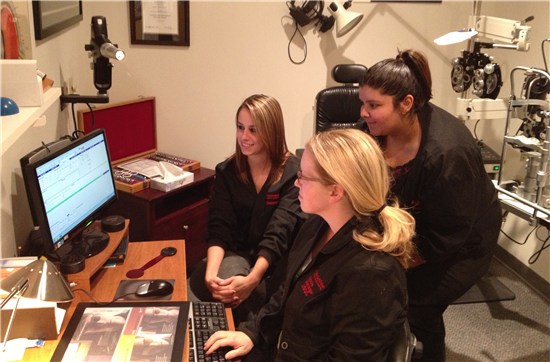By Dale Buettner, OD
Training doctors and optometric employees to use electronic health records begins by training a few “super users.” They, in turn, train peers until the whole staff is up to speed.
When our independent, family-owned optometric company, Wisconsin Vision with 25 locations throughout Wisconsin, transitioned to electronic health records four months ago, we knew we needed a systematic approach. With dozens of ODs and ancillary staff to train, we needed to be organized about how we received training as doctors and how our staffs were trained.
The tiered approach that worked for us was having an initial four doctors in the company receive training–myself among them–and then have those initial four make visits to the company’s many locations to help guide training. The way it worked was once trained, each of us four then trained another three or four doctors who then, in turn, trained their partners and staffs. Here are the highlights of how we implemented this snowball approach to EHR training.

Staff members of Wisconsin Vision gather around a computer to review electronic records.
Have Initial Trainees Trained by Vendor
To lay a strong foundation for your use of EHR, have the first group of users–whether they be doctors or other staff members–trained thoroughly by your vendor. Most vendors, such as ours, Eyefinity OfficeMate ExamWRITER, offer complimentary training with a free help hotline to call for at least the first few months. In our case, a representative from the vendor came to train us in person. Be sure that before the in-person training is complete, that those participating have had an extensive question and answer session to limit time taken away during implementation with multiple calls to the help line.
Have First Users Demo the System Before Implementation
Demo-ing the system using dummy patients before the system goes live will allow you to ensure that you at least know how to document the information required to prove Meaningful Use. After our initial training session with OfficeMate, the most essential element of our training was the access we had to the system prior to implementation. We were able to “play” with the system, filling in such Meaningful Use-required information as allergy and medication lists. We also made sure we knew how to document whether or not all patients over age 13 were smokers, another piece of Meaningful Use-required information.
Learn How to Customize Templates
Ask your vendor trainers–if they don’t suggest it themselves–to help initial users customize frequently-used templates. For instance, you can have a template in the system pre-set up for patients visiting for standard yearly comprehensive examinations in which the reason for the visit is already checked as a default and you can have the system set up so that the user will just have to check one box to indicate that they reviewed information such as HIPAA details with the patient. You also can have templates pre- set up for other categories of visits such as contact lens and emergency eyecare visits. That way staff won’t have to scan through a long list of possible reasons for the office visit to check the appropriate box and pull up the appropriate patient questions for each patient who comes in.
Train Subsequent Users in Notes System
In every EHR system, there is a space for including added notes such as a patient’s difficulty with a certain type of contact lens or a particular complaint they had when taking a medication. There also are usually multiple places in the system to leave these notes. In fact, users often can leave notes in every channel for each patient. For instance, a doctor could leave disparate notes in the contact lens section of a patient’s file and then other notes in another section of the same patient’s file. To ensure no notes would go unread by staff or other practice doctors who saw the patient, we decided that all users would place patient notes in the “patient management” section of each patient’s file and that we would input those notes in all capital letters to ensure they would not be missed. When initial users of the system trained subsequent users, we made sure they trained them in this system of leaving notes.
Create Internal Help Line
As I mentioned, most vendors offer an initial complimentary training period in which training reps and a help line is available for new users. But it is best if questions can be fielded by those within your practice. The advantage of having a small group within the practice get trained first is they have struggled with the issues and questions specific to your practice, so when subsequent users in the practice run into the same challenges, they can easily help out. For instance, if your practice sees many patients with a specific condition such as dry eye, glaucoma or macular degeneration, those initial users have already worked through filling in the needed information for such patients in the system. The initial users in your practice not only have entered information into the system for the conditions you most commonly see, but they also have experience using the system in the context of your office’s workflow–something a vendor trainer lacks.
Have New Users Gradually Transition to Full Use
As each of us became trained on the system and readied for implementation, we were realistic. We knew we wouldn’t be able to handle a full patient load when first implementing EHR, so we had the doctors begin by just trying to use EHR on a reduced schedule that slightly built throughout that first week of implementation until they were up to their full patient load again.
Related ROB Articles
Personalized Patient Care with Help from Your EHR System
Use EHR to Enhance the Patient Experience
Utilize Your EHR System as a Business-Building Tool for the Optical Dispensary
Dale Buettner, OD, is a partner of Wisconsin Vision, practicing out of the company’s Franklin, Wis., office. He can be reached at: Dale.Buettner@gmail.com.





















